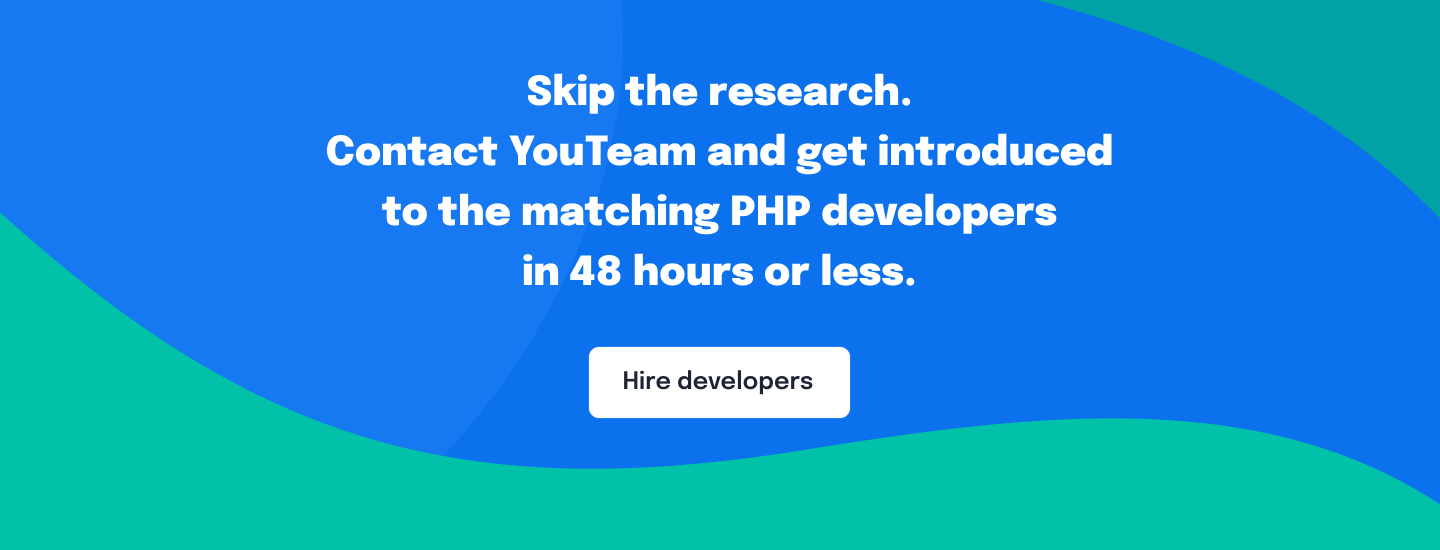Welcome to YouTeam’s guide on interviewing for Senior PHP Developer roles. With plenty of experience in holding interviews with developers, we’ve learned that finding the right person is about more than just technical skills. It’s about finding someone who fits well with your team and goals. This is true for both full-time and contractor positions.
PHP development can be complex, covering everything from basic programming to security and how to make things run faster. Interviews are key for seeing what a developer really knows and how they solve problems. Based on our experience, we’ve put together a set of questions that aim to test not just knowledge, but how candidates think and work. These questions cover a wide range of topics in PHP development and are designed to help you understand the abilities and approach of your potential hires better. In addition to this, each question has two additional follow-up questions that allow you to dive deeper into the topic.
Table of Contents
1: What are PHP Generators, and how do they improve memory efficiency?
Expected Answer: PHP Generators provide me with a simple way to implement iterators without the overhead of implementing the “Iterator” interface. They allow me to iterate through data sets using a “yield” keyword. Generators improve memory efficiency for me by not requiring the entire dataset to be loaded into memory upfront. Instead, values are generated on the fly as they are needed.
Explanation: Generators are particularly useful for working with large datasets, like processing lines in a file or results from a database query, as they allow the script to use a significantly smaller amount of memory compared to loading all data at once.
1.1: How does the “yield” keyword function within a generator?
Expected Answer: The “yield” keyword pauses the generator’s execution and sends its value back to the caller. When the generator is called again, its execution resumes from where it left off, after the last “yield” statement.
Explanation: This behavior makes the “yield” keyword act like a return statement but for generators, allowing the function to produce a series of values over time rather than computing them all at once and returning them in a bulk.
1.2: Can a PHP generator return a final value, and if so, how?
Expected Answer: Yes, a PHP generator can “return” a final value using the return statement. I can retrieve the final returned value using the “getReturn()” method on the generator object after the generator has finished iterating.
Explanation: This feature is useful for scenarios where the generator needs to signal a result or status after completing its iteration, providing a way to communicate a final value back to the caller.
2: What are Prepared Statements and why are they important in PHP?
Expected Answer: Prepared Statements are a feature that I frequently use in database management systems to execute the same or similar SQL statements repeatedly with high efficiency. In PHP, utilizing Prepared Statements is crucial for me due to security and performance reasons. They safeguard against SQL injection attacks by separating the SQL code from the data through parameterization.
Explanation: Besides improving security, Prepared Statements reduce parsing time as the SQL statement is compiled once and can be executed multiple times with different parameters, enhancing the performance of database operations.
2.1: How do you use Prepared Statements with PDO in PHP?
Expected Answer: To employ Prepared Statements with PDO, I initially prepare an SQL statement with placeholders, execute it by providing the input values as parameters, and then fetch the results. For instance:
$stmt = $pdo->prepare('SELECT * FROM users WHERE email = :email');
$stmt->execute(['email' => $userEmail]);
$rows = $stmt->fetchAll();
Explanation: This process separates the data from the SQL command, with the “:email” placeholder replaced by the actual email address when the statement is executed, preventing direct insertion of user input into the query.
2.2: What are the advantages of using mysqli over PDO for database interactions?
Expected Answer: While both mysqli and PDO serve as viable options for conducting database interactions in PHP, mysqli offers me a procedural API alongside the object-oriented API, which I find simpler for basic operations. Additionally, mysqli tends to be marginally faster than PDO for MySQL-specific operations due to its native specialization. However, PDO boasts support for multiple databases, rendering it more versatile.
Explanation: The choice between mysqli and PDO often comes down to the specific needs of the project, such as database compatibility and developer preference for procedural or object-oriented coding styles.
3: What is the significance of using Composer in PHP projects?
Expected Answer: Composer is a dependency management tool for PHP, allowing developers to manage their project’s libraries and dependencies efficiently. It automates the process of installing, updating, and managing libraries, ensuring that a project has all the required dependencies it needs, along with the correct versions, thereby significantly simplifying project setup and maintenance.
Explanation: Composer works by reading a “composer.json” file in your project directory, which specifies the required PHP packages. It downloads these packages and their dependencies, if any, into the project, making it easier to manage and update them.
3.1: How do you specify version constraints for a package in Composer?
Expected Answer: To specify version constraints in Composer, I utilize semantic versioning within the “composer.json” file. Examples include exact versions (“1.2.3”), wildcard versions (“1.2.*”), range constraints (“>=1.2,<2.0”), and tilde and caret versions (“~1.2” and “^1.2”). Each of these specifies a different strategy for updating dependencies while avoiding breaking changes.
Explanation: These constraints allow developers to control how updates to dependencies are handled, balancing the need for stability with the desire to leverage new features and fixes.
3.2: What is the purpose of the “composer.lock” file, and why should it be committed to version control?
Expected Answer: The “composer.lock” file locks the project to specific versions of the dependencies installed, ensuring that all team members and deployment environments use the same versions. Committing it to version control, I ensure that all team members and environments use identical dependency versions, preventing inconsistencies and potential bugs stemming from version disparities.
Explanation: This file is crucial for maintaining consistency in project environments, aiding in debugging and in ensuring that deployments are reliable and reproducible.
4: How does PHP 7 improve performance over previous versions, and what are the key changes?
Expected Answer: PHP 7 introduced significant performance improvements mainly due to the new Zend Engine III, also known as PHPNG (PHP Next-Gen). Key changes include optimized memory usage, improved execution time, and a new, more efficient AST-based compilation process. These improvements result in faster code execution and reduced server resource consumption.
Explanation: The performance leap between PHP 5.x and PHP 7.x is substantial, making PHP 7 more suitable for high-load applications. This version also introduced type declarations for scalar data types, enhancing code quality and maintainability.
4.1: What are scalar type declarations, and how do they benefit PHP code?
Expected Answer: Scalar type declarations enable me to specify the type of value (e.g., int, float, string, bool) expected to be passed to a function or returned from it. This feature betters code clarity and robustness by allowing PHP to enforce type correctness, which helps in detecting bugs and errors early in the development cycle.
Explanation: Type declarations make the code more self-documenting and reduce the risk of type-related bugs, contributing to overall code quality and maintainability.
4.2: What is the null coalescing operator, and how is it used in PHP 7?
Expected Answer: The null coalescing operator (“??”) is a syntactic shorthand for the common case of needing to use a ternary operator in conjunction with “isset()”. It returns the first operand if it exists and is not null; otherwise, it returns the second operand. Example: “$username = $_GET[‘user’] ?? ‘guest’;”
Explanation: This operator simplifies code that needs to check for the presence or absence of a value, making the code cleaner and more readable.
5: What are PSRs, and why are they important in PHP development?
Expected Answer: PSRs (PHP Standards Recommendations) are standards proposed by the PHP Framework Interop Group (FIG) that aim to standardize programming concepts in PHP development. They cover coding style, design patterns, and interfaces, among other things. PSRs are important because they promote a consistent coding standard across different PHP projects, making code more readable, maintainable, and interoperable.
Explanation: Adopting PSRs can enhance collaboration among developers, ease the integration of third-party libraries, and improve the overall quality and reliability of the codebase.
5.1: Can you explain PSR-4 and its significance in modern PHP applications?
Expected Answer: PSR-4 is an autoloading standard that specifies how to map namespaces and class names to file paths, aiming to streamline class loading. It replaces PSR-0 by providing a more flexible directory structure. PSR-4 is significant because it simplifies the autoloading process, reduces the need for numerous “require” statements, and facilitates a more organized and modular project structure.
Explanation: By adhering to PSR-4, developers can ensure that their class files are automatically loaded as needed, making it easier to develop and maintain large-scale, modular PHP applications.
5.2: How does the PSR-7 standard influence HTTP message handling in PHP?
Expected Answer: PSR-7 standardizes HTTP message interfaces, covering both HTTP requests and responses. It defines interfaces for “Request”, “Response”, “Stream”, and other relevant objects, allowing developers to use middleware in a more standardized way. This standard makes the HTTP message handling process more interoperable across frameworks and libraries, facilitating the development of web applications and APIs.
Explanation: PSR-7’s abstraction of HTTP messages encourages a more middleware-oriented approach to building web applications, enabling more reusable and framework-agnostic code.
6: Explain the concept of Namespaces in PHP and their significance.
Expected Answer: Namespaces in PHP are a way of encapsulating items such as functions, classes, and constants to prevent name conflicts. They are particularly useful in large applications and when integrating third-party libraries, allowing for the same names to be used in different namespaces without collision.
Explanation: Namespaces help organize code into logical groups and avoid naming conflicts in larger projects or when using external libraries, enhancing code modularity and maintainability.
6.1: How do you declare a namespace in PHP, and how can it be used in a project?
Expected Answer: A namespace is declared at the beginning of a PHP file using the “namespace” keyword followed by the name of the namespace. It can be used in a project to organize code into logical groups. To access a namespaced class, function, or constant, you must use its fully qualified name or the “use” keyword to import it.
Explanation: This structure allows for better organization of code and prevents name collisions, making code more readable and maintainable.
6.2: Can you explain how to use namespace aliasing in PHP and provide a use case?
Expected Answer: Namespace aliasing in PHP is done with the “use” keyword, allowing for shorter names instead of fully qualified names. For example, “use My\Long\Namespace\Name as ShortName;” lets you use “ShortName” as an alias for the long namespace. This is particularly useful when dealing with deeply nested namespaces or when using multiple classes with the same name from different namespaces.
Explanation: Namespace aliasing simplifies code readability and maintenance, especially in large projects with deep namespace hierarchies or multiple libraries with class name overlaps.
7: What is the purpose of Traits in PHP, and how do they differ from Interfaces?
Expected Answer: Traits in PHP are a mechanism for code reuse in single inheritance languages like PHP. They allow developers to create reusable methods that can be included in multiple classes. Unlike Interfaces, which define a contract for classes without implementing any logic, Traits can provide actual method implementations.
Explanation: Traits help to overcome PHP’s single inheritance limitation by allowing a class to use multiple Traits, thus enabling a form of horizontal code reuse. This is different from interfaces which are used for defining a common API without implementation details.
7.1: Can you provide an example of how to use a Trait in a PHP class?
Expected Answer:
trait Logger {
public function log($message) {
echo $message;
}
}
class MyClass {
use Logger;
}
$obj = new MyClass();
$obj->log("This is a log message.");
Explanation: In this example, the “Logger” trait is defined with a “log” method, which is then used by the “MyClass” class. This shows how Traits can be used to share methods across classes.
7.2: How do Traits resolve method name conflicts, and what is the significance of the insteadof and as operators in this context?
Expected Answer: When two Traits inserted into a class have methods with the same name, PHP requires explicit resolution of the conflict. The “insteadof” operator is used to specify which method to use, and the “as” operator can alias a method from a Trait. This mechanism ensures that the correct method implementations are used, avoiding ambiguity.
Explanation: This conflict resolution feature is crucial for maintaining clear and predictable behavior in classes that use multiple Traits, ensuring that method naming conflicts are resolved explicitly by the developer.
8: Describe the lifecycle of a PHP script from request to response.
Expected Answer: The lifecycle of a PHP script starts with the client sending a request to the server. The server’s web server software (e.g., Apache, Nginx) interprets the request and forwards it to the PHP interpreter if it’s targeted at a PHP script. The PHP interpreter then executes the script, which may involve parsing PHP code, executing functions, and interacting with external systems like databases. Finally, the script generates a response (typically HTML), which is sent back to the client via the web server.
Explanation: Understanding the lifecycle is important for optimizing performance, debugging, and securing PHP applications, as it encompasses everything from request handling to resource cleanup after the response is sent.
8.1: How does PHP handle sessions during this lifecycle?
Expected Answer: PHP handles sessions by assigning a unique session ID to each user session and storing session data either on the server’s file system, in memory, or in a database. The session ID is typically communicated via cookies. When a request is received, PHP checks for a session ID, starts or resumes the corresponding session, and makes session data available to the script.
Explanation: Sessions are key for maintaining state across multiple requests from the same client, enabling functionalities like user logins, shopping carts, and personalized content.
8.2: What role does the PHP.ini file play in the script lifecycle?
Expected Answer: The “php.ini” file is the primary configuration file for the PHP interpreter. It controls many aspects of PHP’s behavior by setting configuration directives. These can affect the script’s lifecycle by modifying settings related to performance (like memory limits and execution time), security (such as disabled functions and extensions), and functionality (file uploads, session handling, etc.).
Explanation: The “php.ini” file allows for the customization of the PHP environment to meet the specific needs of an application, affecting both how scripts are executed and how resources are managed.
9: Explain the use of the “finally” block in PHP exception handling.
Expected Answer: The “finally” block is used in try-catch exception handling in PHP to define code that should be executed after the try and catch blocks, regardless of whether an exception was thrown or caught. It’s typically used for cleanup tasks, like closing files or connections, that should occur whether or not an exception occurred.
Explanation: Using a “finally” block ensures that crucial cleanup code is executed, enhancing the reliability and maintainability of error handling in PHP applications.
9.1: How does exception handling change with PHP 7, particularly with the introduction of Throwable?
Expected Answer: In PHP 7, the introduction of the “Throwable” interface changed exception handling by allowing both Error and Exception types to be caught in catch blocks. This change expanded error handling capabilities, allowing developers to catch and handle fatal errors that were previously uncatchable at runtime.
Explanation: This enhancement makes it easier to write robust applications by providing a unified way to catch both exceptions and errors, preventing potential crashes and allowing for smoother error recovery.
9.2: Can you catch multiple exceptions in a single catch block in PHP, and if so, how?
Expected Answer: Yes, as of PHP 7.1, you can catch multiple exception types in a single catch block by separating them with the pipe (“|”) character. This allows for more concise and readable code when handling exceptions that can be dealt with in the same manner.
Explanation: This feature simplifies exception handling by allowing a single block of code to respond to different exceptions that require similar handling logic, reducing code duplication.
10: What is Object-Oriented Programming (OOP) in PHP, and how does it enhance code reusability and organization?
Expected Answer: OOP in PHP revolves around “objects” containing both data and code, achieved through attributes (properties) and methods. It boosts code reusability via inheritance and polymorphism, while organizing code by encapsulating related properties and behaviors into objects, fostering modularity and clarity.
Explanation: OOP principles help developers create more flexible, modular, and maintainable code, enabling the building of complex applications with reusable components.
10.1: How do you implement interfaces in PHP, and what are their benefits?
Expected Answer: In PHP, I define interfaces using the “interface” keyword, specifying methods that implementing classes must define. Interfaces enforce structure on classes, promoting loose coupling and high cohesion, thereby enhancing flexibility and interoperability.
Explanation: The use of interfaces allows for the design of components that communicate through well-defined contracts, facilitating code reuse and making the system easier to understand and modify.
10.2: Explain the concept of late static bindings in PHP, and provide a use case.
Expected Answer: Late static binding in PHP enables static method calls to resolve based on the runtime class, rather than the defining class. This feature ensures static calls behave predictably in complex class hierarchies, especially when a parent class method should return data from the calling class.
Explanation: Late static bindings provide greater flexibility in OOP, particularly in complex inheritance hierarchies, by ensuring that static method calls behave more predictably when dealing with extended or child classes.
Final thoughts
As we conclude our guide on interviewing senior PHP developers, it’s clear that the journey to find the right candidate involves a delicate balance of technical prowess, problem-solving abilities, and team fit. The 10 essential questions we’ve outlined, complemented by their expected answers and explanations, serve as a comprehensive tool to gauge not only a candidate’s PHP expertise but also their approach to common development challenges.
Remember, the goal of these questions and follow-ups is not merely to challenge the candidates but to initiate meaningful conversations that reveal their thought processes, problem-solving strategies, and enthusiasm for PHP development. By fostering an environment where candidates can showcase their skills and personality, you stand a better chance of identifying the right match for your team.
We hope this guide serves as a valuable resource in your search for a senior PHP developer who not only meets but exceeds your expectations, driving your projects forward with expertise, innovation, and a collaborative spirit. Happy interviewing!







